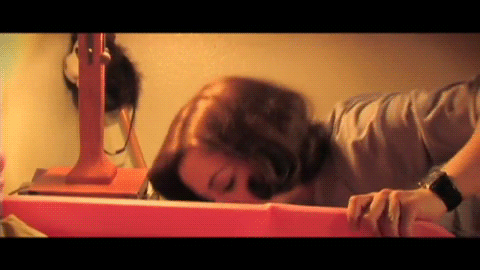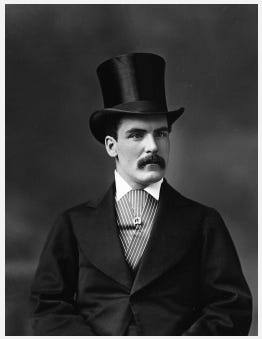A Homicidal Doctor and Boxes of Fun!
Vol. 128: Apple brownies are a delight. Just so you know.
A Big Ol’ Box of Frights!
Have you experienced the thrill of receiving a subscription box? It’s like sending yourself a scheduled surprise. What never-seen-before horrors will this month hold?
Here’s a round-up of subscription boxes that specialize in horror. They usually include curated books, sometimes special editions, and other items made just for that company. They make perfect gifts for yourself or some horror-loving friend who is aggravatingly impossible to shop for.
Twisted Retreat- You have the option of a monthly book-only box or the complete box. That can include things like a t-shirt or home décor items, candles, bath products and a beverage or food item. You can also shop for individual items from previous boxes, like the amazing pizza cutter shaped like Wendy’s ax from The Shining.
Night Worms- This box focuses more on the reads than the related merch. Each box has at least two books, but you may also get a magazine, bookmarks, a magnet, and a beverage item like coffee. And they ship to a few countries outside the US.
Underworld Connection- This company is about horror themed body products! You have four options of subscription sizes, with prices starting at $25. Each month has a theme such as “Creepy Carnival” or “Movie Monster Mash” where you’ll receive uniquely scented body scrubs and butters, candles and snacks. Try not to eat the funnel cake scented body scrub.
Culture Fly- Still mourning the end of Supernatural? Culture Fly has a quarterly box that includes tons of bespoke items like clothing, mugs, dolls and home décor. You won’t find these items anywhere else.
Blind Date with a Horror Book- On Etsy, this one is a order-as-you-like deal, so you’ll have to place your order each month. What you’ll get is a themed box filled with unique items that includes a horror book, flashlight, journal and pen, and other items such as horror movie t-shirts, socks or tea.
Apple Brownies
recipe from The Apple Lover’s Cookbook by Amy Traverso
Technically, they should be called “blondies” as there’s no chocolate, just a delicious apple-cinnamon bar that is so good that The Giant asked for these last month instead of a birthday cake. I’ve added my two cents in the ingredients.
1 c flour
1 tsp cinnamon (I always add 2 tsp.)
½ tsp baking powder
¼ tsp baking soda
½ tsp salt
1 stick of butter, melted and cooled, plus extra for the pan. (I use parchment paper)
1 c sugar
1 large egg (I use two)
½ c chopped walnuts
2 large firm-sweet apples, diced. (Use Cosmic Crisp, Sweet Tango, Pink Lady, Jonagold...a variety that retains its shape in the oven.)
A few drops of apple extract (optional)
Preheat the oven to 350F. Butter an 11x7 baking dish, or use parchment.
Whisk together the flour, cinnamon, baking powder and soda and the salt. Set aside.
In a mixer, beat the butter, sugar and egg, and the extract if you’re using it. Beat on high for 2 minutes. Add the flour mixture and mix on medium until combined. Add the apples and nuts and stir in by hand. Spread in the prepared pan and bake until golden brown, 40-50 minutes. The top should be lightly firm.
Cool and cut into bars. Great with maple ice cream!
SPOOKY BOOKY
The Spite House by Johnny Compton
Tor Trade, 2023
Eric and his daughters have been driving around aimlessly for over a year. They live in motels while Eric and teenage Dess do odd jobs to earn just enough to keep them going. Now they’ve returned to the Hill Country of Texas, a place Eric spent his childhood with his grandparents and great-grandparents. His memories of his great-grandfather being a man who people feared still haunt him, and he’s filled with questions about whether his younger daughter has inherited a strange gift.
Eric’s financial situation is dire enough that he answers an ad for someone to live in a haunted house. The owner, an elderly woman who can buy anything or anyone, wants absolute proof that the building she owns is haunted. The family, and the reader, are soon wondering just how much Eunice knows about what goes on in the house, and if she cares what happens to Eric and his girls.
I’d never heard the term “spite house” before, but it appears that they do exist, structures built just as a dig at another homeowner, such as ruining their view. Spooky atmosphere, economics, race, and the secrets of two families make this one juicy haunted house story. Scare Scale: 3.5
The Demonic Doctor: Thomas Neill Cream
Now we’re getting to one of the “classics” of British murder. There was a time when Americans knew his name as well as any Brit, because this guy… Well, let’s start with his appearance and we’ll go from there.
He looks like he would demand the crusts be removed from his watercress sandwich because they would make his Little Lord Fauntleroy gums bleed. He looks like he would wag his gold-handled stick while saying, “Less of you.” He looks like his laugh would come out as “Har har har!”
We have to admit that he was able to put up a good front with his expensive clothes and giant mustache, but Cream wasn’t all that smart. Instead, he was lucky, and that did him well enough for a long time.
Thomas Neill Cream was born the son of a shipmaker in Glasgow in 1850. He would be the first of eight siblings. His family moved to Canada when he was four, right outside Quebec City, and his father opened his own lumber business. It would be a great success, enabling Thomas to attend McGill University in Montreal, where he received a medical degree in 1876. His father’s money also gave Thomas the means to be a dandy. He loved expensive clothes and carriages, and wore flashy jewelry.
1876 was also the year that he met and impregnated a woman named Flora Brooks, who would be his first victim, intentional or not. Cream performed an abortion on Flora that went very badly, ruining her health. He fled to Montreal, but Flora’s father, a hotelier, chased Cream down and dragged him back for the quickie wedding. Then Cream was allowed to leave. He took the opportunity to run all the way back to Scotland and became qualified as a surgeon in Edinburgh. Flora died the following year, the cause kindly listed as “consumption” rather than speaking of the botched abortion that left her in agony.
Cream returned to Canada, opening a private practice in London, Ontario in 1878, even though he wasn’t licensed in Canada. His first murder, officially, occurred in 1879, when the body of Catherine Gardner was found in Cream’s office outhouse with an empty bottle of chloroform beside her. Evidence showed that she’d died from a cloth soaked in chloroform being held over her face. It was ruled a suicide after Cream told the police that Gardner had hounded him to perform an abortion on her, and he produced a letter from her in which she wrote of her unwanted pregnancy and named a local businessman as the father. This ludicrous letter was accepted by the police even though Gardner’s family pointed out that it wasn’t Gardner’s writing. If the authorities had looked into Cream, since the body was found on his premises, they might have found that his university thesis had been on the effects of chloroform. Cream repeatedly stressed the businessman’s name as the cause of Gardner’s suicide but her family never believed Cream’s story and there was enough suspicion about his involvement that he had to close his practice. Take note of his attempt to pin this crime on someone else, it became a habitual part of his activities.
He had opened a practice in the slums of Chicago by 1880 and was known locally as an abortionist. His first American murder victim was a woman named Mary Anne Faulkner who died after an operation, most likely an abortion. Cream was investigated but the charges were dropped. Within months another patient, Ellen Stack, died after taking pills he’d prescribed. As authorities again investigated, Cream wrote a letter to the pharmacist Stack had frequented, threatening to expose him as a murderer unless he paid up. Once again, there were no charges against Cream.
A few months later, in April 1881, the body of Alice Montgomery was found in her boarding house room. She’d suffered through a botched abortion, but strychnine poisoning was found to be her cause of death. Cream’s office was very nearby and he had a steady trade in performing abortions for prostitutes, as nearly all Cream’s American victims were.
Three months later, there was an aberration in Cream’s behavior, a death that showed something other than the usual impulse murder. He went to the home of 61 year-old Daniel Stott, an epileptic who died very soon after Cream left. Analysis found that Stott died of strychnine poisoning, and this time, the police did a thorough investigation. Cream was cornered.
The police found that Julia Stott, Daniel’s 33 year-old wife, had recently talked her husband into taking out a large life insurance policy. Digging further, they also found that Julia and Cream were having an affair.
Julia turned on Cream to save herself, testifying that the murder was all Cream’s idea and that he had intended on taking over all the legal matters on her behalf. Before being charged himself, Cream had contacted the D.A. and demanded that the pharmacist be charged for the murder, saying that the death was due to botched pills.
Julia went free and Cream was sentenced to life in Joliet Prison. He had served less than ten years when his brother arrived, paid some hefty bribes, and Cream was released. He went to England and settled into the seedy area of London known as Lambeth. The year was 1891.
Now his murders occurred fast, like a string of pearls. He’d meet a woman and immediately kill, or attempt to kill her, as if it was a non-stop itch.
He met a woman named Ellen Donworth and kindly offered her a swig of the bottle he was holding. She accepted and died, the bottle left behind found to contain strychnine. Once the murder hit the news, Cream sent an anonymous letter to W.F.D. Smith, founder of W H Smith Books, and attempted to blackmail him by saying he had proof of Smith’s involvement in Donworth’s death. Smith went to Scotland Yard and a trap was set, but Cream never followed up.
The next victim was Matilda Clover. Cream treated her, giving her pills that had her in agony. She died within hours. Cream then tried to blackmail a prominent doctor about this death, who contacted Scotland Yard.
In April, 1892, Cream was back in Canada for a visit, probably to let things cool down in London. He hired two women for the night, Alice Marsh and Emma Shrivell. As he left the next morning, he gave each woman three pills. They both died within hours.
Returning to England, Cream met a New York City policeman, John Haynes, who was visiting London. The two got into a discussion about the murders, the stories being big news in America. Cream couldn’t control his ego and he actually took the officer on a tour of the victim’s residences, giving information about the crimes. Of course, this was too suspicious for Haynes. He relayed the information to local authorities and was told that they were already watching Cream due to the number of letters he wrote denouncing others of being murderers, and they suspected that he was also the anonymous blackmailer of the doctor and Smith. The break came when one of the letters mentioned Matilda Clover as a murder victim. Clover’s death had been listed as natural causes because she was a known alcoholic, but this was the slip that brought Cream down. The blackmailer had to be the killer.
Scotland Yard detectives tailed him. They dug into his past and discovered the poisoning conviction of Daniel Stott, which convinced them that they had the right man. Cream was arrested for the murder of Matilda Clover on June 3, 1892. Weeks later, he was also charged with the murders of Donworth, Marsh and Shrivell, with extortion, and the attempted murder of a Canadian woman who fooled Cream into thinking she’d swallowed the pills he’d given her.
The trial took place at the Old Bailey in London, and Cream gave the court an unintended moment of levity when he read out a letter that was purportedly from Jack the Ripper, in which the Ripper declared Cream’s innocence. The court, and then Cream, erupted in laughter.
Thomas Neill Cream was found guilty of all charges and sentenced to be hanged. As a massive crowd cheered outside the walls, Cream went to the scaffold. It was reported that his last words were, “I’m Jack the-” and then the trapdoor opened and he fell. This confession is unlikely. Several people were present and denied that Cream spoke, but the rumor has kept Cream on the list of suspects for Jack the Ripper. The two murderers both enjoyed sending letters about their crimes and both chose destitute women as victims. But that’s about it. The Ripper enjoyed violence. Cream preferred poisoning, which earned him the name of “The Lambeth Poisoner”. And as he wasn’t clever enough to get away with his crimes, he was in prison in Illinois when the Ripper murders occurred.
I need to shorten my posts, so I’m thinking of including the cocktail/baking recipes only when space permits. Or I can lose the opening pieces and go right to drinking and book reviews. If you have an opinion, now’s the time to speak up.
Next week: The Creep Club will delve into horror on the cheap, and the story of two avoidable deaths. The best baked plans often go a-rye.















Dr. Cream sounds like a real nice fella, does he have a brother?
jkjk, but I think I found his soul mate, another dastardly doctor of Victorian England who preferred poison. From my favorite spooky podcast, which I can only stomach because it's mainly about crimes of distant history:
https://pca.st/episode/9c6a193f-a824-4b0b-8312-76e45dbf6964